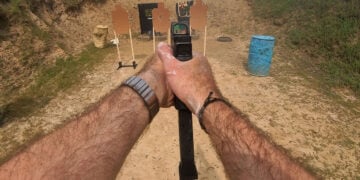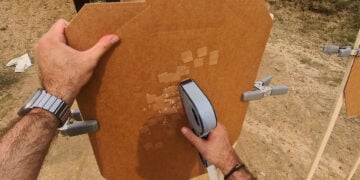Among concealed carriers, the concept of being armed usually revolves around having a firearm on your person. Those of us that commit to carrying a handgun on a daily basis realize that it is the best tool available for self-defense against a lethal threat that can be concealed on the body. For most in the gun community, anything short of a firearm is a poor compromise.
One of the most commonly discussed compromises, however, is an edged weapon. It is common for gun carriers to also carry a blade every day and for a good reason. However, there is a great deal of misconception related to the use of a knife or other blade in self-defense, and those who do indeed factor the edged weapon into their self-defense plan should think it through.
In the opinion of this author, the knife is an absolutely vital part of daily carry, and I say with conviction that if you don’t carry a blade, you are not prepared for the dangers of this world. I consider the knife primarily a cutting tool that may be needed for emergency rescue tasks. As a youth, I got stuck in a seatbelt that would not release, and nobody in the vehicle had a blade. That was the last day I ever left the house without a knife or multi-tool on my person. You are more likely to encounter such a cutting task than you are to face the need to use a knife to fend off an attacker and for such use alone I am an absolute proponent of carrying a blade.
As a defensive tool, it is very secondary for me. Although I do carry my knife opposite my gun side in case I should need to use it in a contact distance struggle in which I could not deploy the gun, but that is essentially as far as I go with considering the knife in my defensive plan. If you factor a blade into your self-defense to a greater extent I urge you to consider some of the following legal and practical issues:
Legal Perception of the Edged Weapon
Something that absolutely must be taken into account is this: in the eyes of the American criminal justice system the edged weapon is considered felonious. If you don’t like that reality just because you are a knife guy, I am sorry, but the reality remains. There are many examples of citizens legitimately defending themselves yet ending up in legal trouble because they used a knife. The sheer fact that an edged weapon was used has caused a judge or jury to scrutinize what would otherwise be clear-cut self-defense on quite a few occasions. This is a ridiculous view held by the judicial system as any weapon used in legitimate self-defense should be considered reasonable, but sadly there is a definite bias against the knife. Bear this in mind. A mentality hangs on that the knife is a weapon favored by the thug and the miscreant.
While I certainly believe in using an edged weapon if that is your only option when faced with a lethal threat, the legal ramifications of doing so should be considered beforehand. A knife is probably more appropriate as a weapon of last resort than as a preferred option. There are those who tend to put a great deal of emphasis on the blade as a weapon, even opting to carry a knife rather than a firearm when they could legally and practically carry a gun, and herein lies both a practical and legal pitfall. While a knife is an obvious choice for a weapon in environments where it is legal while a firearm is not the stigma placed on it should be kept in mind. At all times and in all environments permissible the firearm is the defensive weapon of superior versatility as well as the more favorably viewed defensive option.
Legality of Carry
Unfortunately, there are as many, if not more, ridiculous laws pertaining to the carry of knives as there are to the carry of guns throughout the United States. The truth is when entering restricted environments in which we cannot carry a firearm we often cannot legally carry a blade either. Be sure that you know the laws in your state and jurisdiction.
Many states have absurd knife laws which can get an armed citizen in legal trouble for carrying even a relatively mundane blade even though they can carry any handgun they choose. Quite a few states have ordinances that restrict the carry of fixed blade knives, for example, or at least restrict the blade length. While it might seem crazy that a small fixed blade knife could land you in trouble even though you can legally carry your service sized pistol, such incongruous reasoning is the norm when it comes to restrictions on weapons and it is the sad reality armed citizens face.
Many locations forbid the carry of concealed fixed blades altogether, yet allow concealed folding knives. This should be considered and depending on your environment a folding knife may prove not only a convenience but an issue of legality. Also, be aware that some places have egregious restrictions in place. New York City, for example, forbids the carry of locking folders, so only knives that fold and have no locking safety mechanism are legal. Also, consider that many states have preemption laws which prohibit local jurisdictions from overriding state laws concerning firearms. There is no such preemption in most states for knives. Therefore, your currently legal four-inch folder in your town might be illegal the next town over.
Practicality of Deployment
From the standpoint of practicality, I can tell you that the single most critical component of knife capability is missed by most: the ability to deploy the knife quickly.
If you are going to rely on a knife for self-defense in any capacity the first priority you should set for yourself is the ability to get the knife out quickly. As you might imagine, this is exponentially more difficult with a folding knife than a fixed blade, and it requires a significant amount of training and practice. I have seen individuals spend time learning all sorts of martial arts pertaining to the use of bladed weapons yet never practice actually deploying the folder they carry clipped in their pocket. As with the handgun, the less glamorous skillset proves the most critical. A knife does no good in a defensive situation if it cannot be brought into action quickly and efficiently.
In closing, I urge you to give the blade you carry, and the reason you carry it, some consideration. The knife is fraught with downsides as a defensive weapon and remains problematic in the eyes of the law. It is also a tool that demands far more discipline than most put into it if it is indeed intended as a defensive weapon. Despite the complications of the blade as a weapon, I remind the reader that it is an essential tool for every day carry as you may need it to cut somebody free of a seatbelt or other such emergency. Concealed carriers should certainly carry a blade, but the role of that blade requires some forethought concerning legality and practicality. A knife can be a devastating contact distance weapon, but going about carrying a blade specifically for defensive purposes without the proper considerations is unwise.










First, my credentials to speak on this topic. Some 50 years ago (I am 72 now), I was an Army medic on a SAR/Recon team somewhere overseas. I carried a 1911A1 as my issued sidearm, (yes, all medics carried weapons unless they were Conscientious Objectors, I joined on my own free will) and I always had a knife of some sort on my person when out in the boonies.
During our initial Combat training, we were given rudimentary instruction in using edged weapons. There are several things that stick out in my mind all these years later that seem, to me at least, to be seldom mentioned in today’s self-defense community.
One of those things is what one of our instructors told us in that if we were using an edged weapon to defend ourselves, we needed to prepare ourselves to be cut and possibly cut badly. And to prepare ourselves to understand that it will hurt and we will bleed, probably a lot. I can speak from experience (having been cut by both knives and bayonets) when I say it hurts like hell to be cut, just not at first as the Sympathetic Nervous System, also known as Fight or Flight kind of masks the pain until things calm down . Many people who get cut first will lose the fight because they do not believe that it can happen to them much less that they will bleed as much as they are now suddenly bleeding.
After I got out I became an ER nurse and between the Army and the 30+ years in ER, I have seen a number of people who engaged someone with a knife and did not fare well when theirs was the first blood drawn. It is not like in the movies and people who try to emulate what they have seen the choreographed moves played out by actors will probably lose (another word for assuming room temperature) and get a free ride to the ME’s cooler.
Then there is the concept of training in the use of a knife as a self-defense tool. I use that word, instead of weapon, because if one has not been adequately trained in its use as a weapon, it is just a tool, nothing more, and unfortunately for too many who have not been trained, it will get them killed or seriously wounded if they draw it to use in that manner.
If anyone is carrying a knife as a tactical tool, he needs to have training and practice sparring with a partner using a nonlethal substitute, and practicing more than with any other weapon. Fighting with a knife is more complicated than with a firearm, although the knife can make you just as dead. I have seen too many who thought they were good with their knife only to have the very rude awakening that their demise was imminent as their blood was rapidly leaking onto the ground.
I have carried a knife of some sort ever since the Army, and I have a tactical knife, an Emerson CQC-7 that I have had for close to 30 years in my right rear jeans pocket at this moment. I have never had to deploy it and I am good with that, but I still shadow spar with it frequently. If you don’t practice with a knife, you should never attempt to deploy it. Those who carry but do not practice often become just a page on a police blotter as a listing of the deceased.